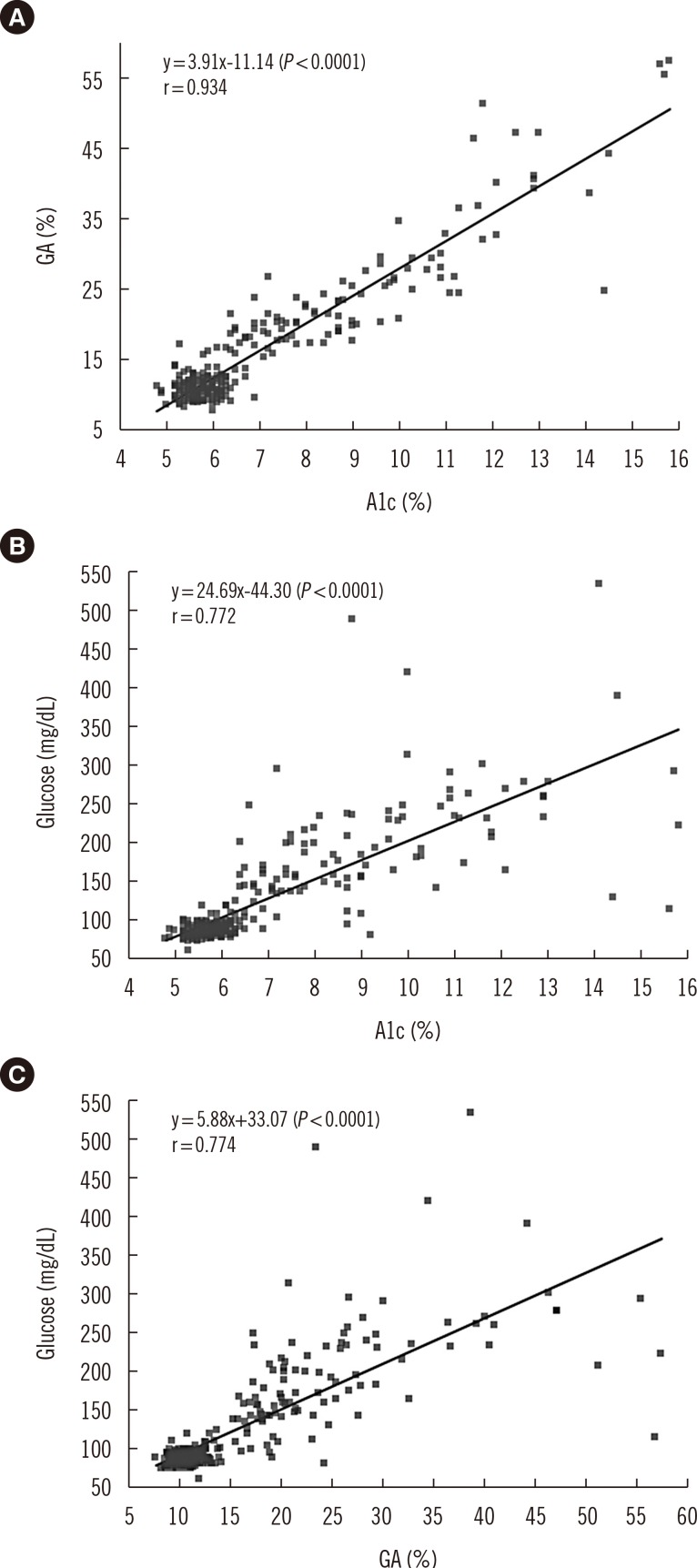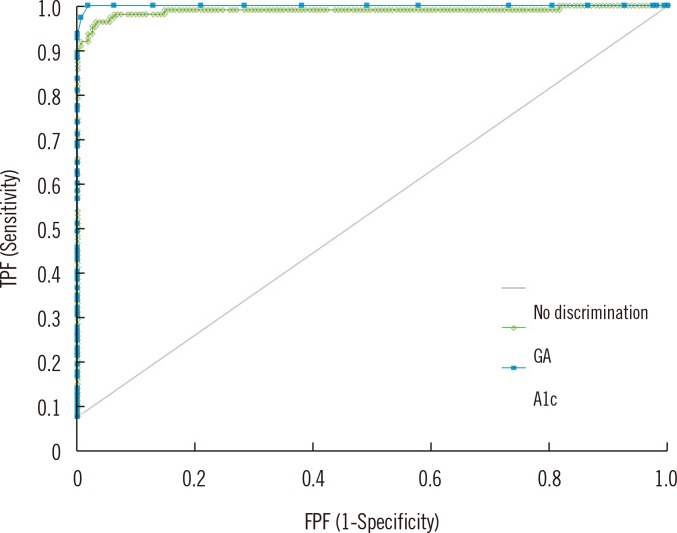Ann Lab Med.
2016 Jul;36(4):306-312. 10.3343/alm.2016.36.4.306.
Diagnostic Utility of Serum Glycated Albumin for Diabetes Mellitus and Its Correlation With Hyperlipidemia
- Affiliations
-
- 1Department of Laboratory Medicine, Ewha Womans University School of Medicine, Seoul, Korea. kshong@ewha.ac.kr
- KMID: 2373549
- DOI: http://doi.org/10.3343/alm.2016.36.4.306
Abstract
- BACKGROUND
Glycated albumin (GA) is a better marker of short-term glycemic control than glycated hemoglobin (A1c). Dyslipidemia is the main cause of cardiovascular complications in diabetes mellitus (DM). Studies on the correlation of GA with lipid indices are sparse. We investigated the diagnostic utility of GA for DM and its relationship with serum lipid profiles compared with that of A1c.
METHODS
The GA enzymatic method was used to determine the diagnostic utility of GA for DM by using samples from 163 normal subjects (group 1) and 102 patients newly diagnosed with type 2 DM (T2DM; group 2). To analyze the lipid profiles, 263 patients with T2DM receiving treatment (group 3) were recruited.
RESULTS
GA correlated with A1c (r=0.934, P<0.0001). Linear regression analysis indicated that GA levels were about 2.48 folds those of A1c. In the ROC analysis for GA to diagnose DM, the areas under the curve (0.988, 95% confidence interval 0.972-1.004) was excellent. HDL levels were significantly lower in groups 2 and 3. In group 1, positive correlations were observed between A1c and triglyceride (TG), total cholesterol (TC), LDL, TG/HDL, TC/HDL, and LDL/HDL levels. A negative correlation was observed between HDL and A1c levels. In group 3, HDL levels (P=0.0124 and P=0.0141, respectively) were significantly higher and LDL levels tended to be lower, not statistically significant, in the well-controlled group categorized using the A1c and GA cut-off values.
CONCLUSIONS
GA is a potential diagnostic tool for DM. Compared with A1c, GA seems less relevant to dyslipidemia.
MeSH Terms
-
Adult
Area Under Curve
Blood Glucose/analysis
Cholesterol, HDL/blood
Cholesterol, LDL/blood
Chromatography, High Pressure Liquid
Diabetes Mellitus, Type 2/complications/*diagnosis/drug therapy
Female
Humans
Hyperlipidemias/complications/*diagnosis
Hypoglycemic Agents/therapeutic use
Linear Models
Lipids/blood
Male
Middle Aged
ROC Curve
Serum Albumin/*analysis
Blood Glucose
Cholesterol, HDL
Cholesterol, LDL
Hypoglycemic Agents
Lipids
Serum Albumin
Figure
Cited by 1 articles
-
A Clue to Discovering Unstable Hemoglobin Variants via Abnormal WBC Differential Scattergrams Using the Sysmex Automated Hematology Analyzer
Sholhui Park, Tae Dong Jeong, Ki-Sook Hong, Jungwon Huh
Lab Med Online. 2019;9(2):84-87. doi: 10.3343/lmo.2019.9.2.84.
Reference
-
1. American Diabetes Association. Standards of medical care in diabetes--2010. Diabetes Care. 2010; 33(S1):S11–S61. PMID: 20042772.2. Roohk HV, Zaidi AR. A review of glycated albumin as an intermediate glycation index for controlling diabetes. J Diabetes Sci Technol. 2008; 2:1114–1121. PMID: 19885300.
Article3. Morrish NJ, Wang SL, Stevens LK, Fuller JH, Keen H. Mortality and causes of death in the WHO Multinational Study of Vascular Disease in Diabetes. Diabetologia. 2001; 44(S2):S14–S21. PMID: 11587045.
Article4. Expert Panel on Detection Evaluation, and Treatment of High Blood Cholesterol in Adults. Executive summary of the third report of the National Cholesterol Education Program (NCEP) expert panel on detection, evaluation, and treatment of high blood cholesterol in adults (Adult Treatment Panel III). JAMA. 2001; 285:2486–2497. PMID: 11368702.5. ADVANCE Collaborative Group. Patel A, MacMahon S, Chalmers J, Neal B, Billot L, et al. Intensive blood glucose control and vascular outcomes in patients with type 2 diabetes. N Engl J Med. 2008; 358:2560–2572. PMID: 18539916.
Article6. Giansanti R, Rabini RA, Romagnoli F, Fumelli D, Sorichetti P, Boemi M, et al. Coronary heart disease, type 2 diabetes mellitus and cardiovascular disease risk factors: a study on a middle-aged and elderly population. Arch Gerontol Geriatr. 1999; 29:175–182. PMID: 15374070.
Article7. Shai I, Rimm EB, Hankinson SE, Curhan G, Manson JE, Rifai N, et al. Multivariate assessment of lipid parameters as predictors of coronary heart disease among postmenopausal women: potential implications for clinical guidelines. Circulation. 2004; 110:2824–2830. PMID: 15492318.8. Asztalos BF, Roheim PS, Milani RL, Lefevre M, McNamara JR, Horvath KV, et al. Distribution of ApoA-I-containing HDL subpopulations in patients with coronary heart disease. Arterioscler Thromb Vasc Biol. 2000; 20:2670–2676. PMID: 11116070.
Article9. Ogawa A, Hayashi A, Kishihara E, Yoshino S, Takeuchi A, Shichiri M. New indices for predicting glycaemic variability. PLoS One. 2012; 7:e46517. PMID: 23029543.
Article10. Rubenstein DA, Maria Z, Yin W. Glycated albumin modulates endothelial cell thrombogenic and inflammatory responses. J Diabetes Sci Technol. 2011; 5:703–713. PMID: 21722586.
Article11. Dobrian A, Simionescu M. Irreversibly glycated albumin alters the physico-chemical characteristics of low density lipoproteins of normal and diabetic subjects. Biochim Biophys Acta. 1995; 1270:26–35. PMID: 7827132.
Article12. Bucala R, Makita Z, Vega G, Grundy S, Koschinsky T, Cerami A, et al. Modification of low density lipoprotein by advanced glycation end products contributes to the dyslipidemia of diabetes and renal insufficiency. Proc Natl Acad Sci U S A. 1994; 91:9441–9445. PMID: 7937786.
Article13. American Diabetes Association. Standards of medical care in diabetes--2014. Diabetes Care. 2014; 37(S1):S14–S80. PMID: 24357209.14. Kohzuma T, Yamamoto T, Uematsu Y, Shihabi ZK, Freedman BI. Basic performance of an enzymatic method for glycated albumin and reference range determination. J Diabetes Sci Technol. 2011; 5:1455–1462. PMID: 22226265.
Article15. Kouzuma T, Uemastu Y, Usami T, Imamura S. Study of glycated amino acid elimination reaction for an improved enzymatic glycated albumin measurement method. Clin Chim Acta. 2004; 346:135–143. PMID: 15256314.
Article16. Little RR. Glycated hemoglobin standardization--National Glycohemoglobin Standardization Program (NGSP) perspective. Clin Chem Lab Med. 2003; 41:1191–1198. PMID: 14598869.
Article17. Taylor R. Interpretation of the correlation coefficient: a basic review. J Diagn Med Sonogr. 1990; 1:35–39.
Article18. Lu L, Pu LJ, Xu XW, Zhang Q, Zhang RY, Zhang JS, et al. Association of serum levels of glycated albumin, C-reactive protein and tumor necrosis factor-alpha with the severity of coronary artery disease and renal impairment in patients with type 2 diabetes mellitus. Clin Biochem. 2007; 40:810–816. PMID: 17499233.19. Nathan DM, McGee P, Steffes MW, Lachin JM. DCCT/EDIC Research Group. Relationship of glycated albumin to blood glucose and HbA1c values and to retinopathy, nephropathy, and cardiovascular outcomes in the DCCT/EDIC study. Diabetes. 2014; 63:282–290. PMID: 23990364.
Article20. Furusyo N, Koga T, Ai M, Otokozawa S, Kohzuma T, Ikezaki H, et al. Utility of glycated albumin for the diagnosis of diabetes mellitus in a Japanese population study: results from the Kyushu and Okinawa Population Study (KOPS). Diabetologia. 2011; 54:3028–3036. PMID: 21947435.
Article21. Garlick RL, Mazer JS. The principal site of nonenzymatic glycosylation of human serum albumin in vivo. J Biol Chem. 1983; 258:6142–6146. PMID: 6853480.
Article22. Gallagher EJ, Le Roith D, Bloomgarden Z. Review of hemoglobin A(1c) in the management of diabetes. J Diabetes. 2009; 1:9–17. PMID: 20923515.
Article23. Arasteh A, Farahi S, Habibi-Rezaei M, Moosavi-Movahedi AA. Glycated albumin: an overview of the In Vitro models of an In Vivo potential disease marker. J Diabetes Metab Disord. 2014; 13:49. PMID: 24708663.
Article24. Ma XJ, Pan JM, Bao YQ, Zhou J, Tang JL, Li Q, et al. Combined assessment of glycated albumin and fasting plasma glucose improves the detection of diabetes in Chinese subjects. Clin Exp Pharmacol Physiol. 2010; 37:974–979. PMID: 20557319.
Article25. Mooradian AD. Dyslipidemia in type 2 diabetes mellitus. Nat Clin Pract Endocrinol Metab. 2009; 5:150–159. PMID: 19229235.
Article26. Khan HA, Sobki SH, Khan SA. Association between glycaemic control and serum lipids profile in type 2 diabetic patients: HbA1c predicts dyslipidaemia. Clin Exp Med. 2007; 7:24–29. PMID: 17380302.
Article27. Yan Z, Liu Y, Huang H. Association of glycosylated hemoglobin level with lipid ratio and individual lipids in type 2 diabetic patients. Asian Pac J Trop Med. 2012; 5:469–471. PMID: 22575980.
Article28. ACCORD Study Group. Ginsberg HN, Elam MB, Lovato LC, Crouse JR 3rd, Leiter LA, et al. Effects of combination lipid therapy in type 2 diabetes mellitus. N Engl J Med. 2010; 362:1563–1574. PMID: 20228404.
Article
- Full Text Links
- Actions
-
Cited
- CITED
-
- Close
- Share
- Similar articles
-
- Alternative biomarkers for assessing glycemic control in diabetes: fructosamine, glycated albumin, and 1,5-anhydroglucitol
- The Roles of Glycated Albumin as Intermediate Glycation Index and Pathogenic Protein
- Review of the Potential Glycemic Markers Glycated Albumin and 1,5-anhydroglucitol
- The Glycated Albumin to Glycated Hemoglobin Ratio Might Not Be Associated with Carotid Atherosclerosis in Patients with Type 1 Diabetes
- Serum glycated albumin as a new glycemic marker in pediatric diabetes



